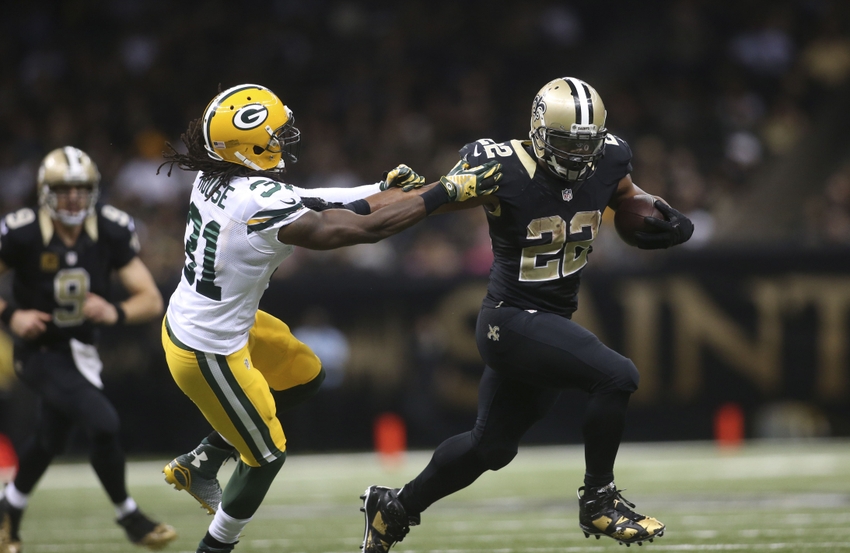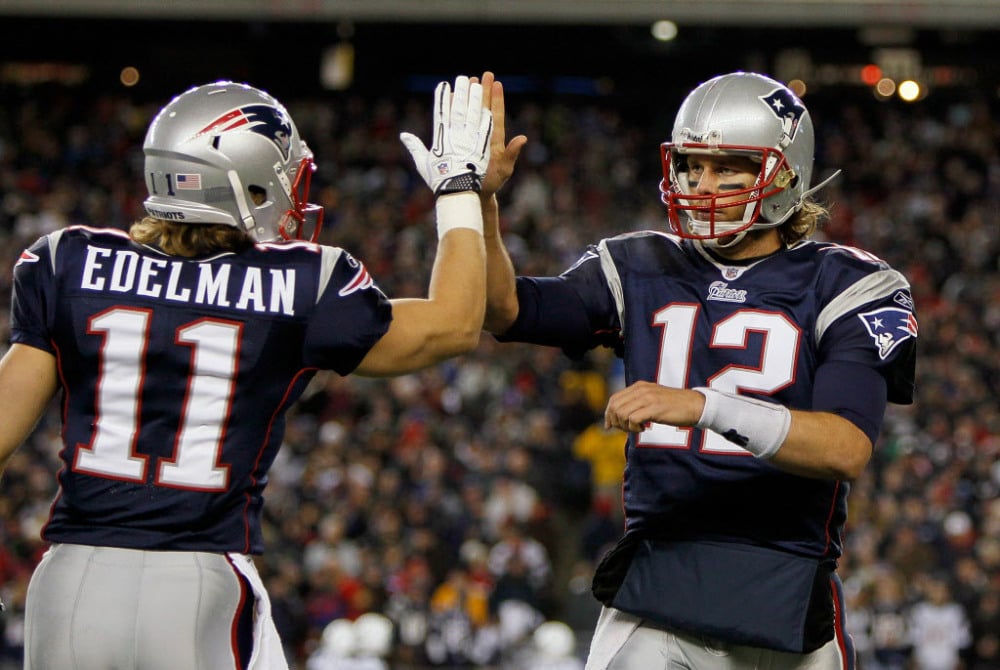This article is about why we maybe think we know more about positional correaltions in NFL DFS than we actually do. I have to give a tip of the cap to the below Twitter user who gave me the idea for the article (so here’s who you can blame for what’s to follow:)
I think most people who frequent this site would have the same initial reaction that, yes, it is sub-optimal to use Cooks and Ingram on the same DFS team. WR1 and RB1 have a negative correlation, meaning that when one performs well, the other is likely to do a little bit worse. This is mostly rooted in game script, since trailing teams may abandon the run to throw more and leading teams will probably lean on running game and short passing game to control time of possession. (As it turned out, the play was sub-optimal because the Saints are horrible, but that’s beside the point.)
But then I started thinking a little bit more, specifically about what types of players these two are. When you decide to use Mark Ingram, you’re hoping he dominates the red zone touches in the game and comes through with at least one touchdown. With Brandin Cooks, you’re hoping he racks up a ton of catches and maybe breaks one loose for a long score.
In addition to game script concerns when stacking RB1-WR1, you might be worried that they will vulture each other’s touchdowns. Randall Cobb and Mike Wallace each had more red zone touchdowns than their team’s leading rusher in 2014, so you run the risk of having two players on your team fighting for the same six points.
Is it always like that though? Can some WRs help their RB be more DFS-successful when they are playing well and vice versa?
Going back to “what we want” from each player, we want Ingram to get most of the red zone work for the Saints when we use him in DFS. If Cooks is going to take away from Ingram’s touchdown potential, then the negative correlation is obvious. So I dug into this a little bit deeper using Football Guys’ Red Zone Summary tool and here’s what I found:
• Red zone touches in 2015: Ingram 8, Cooks 1
• Red zone touches in 2014: Ingram 50, Cooks, 10
• Combining 2014 & 2015, Ingram has 9 red zone touchdowns, Cooks has 1
• In 2014 & 2015, 642 of Cooks’ 660 receiving yards have come outside the red zone (97%)
By looking at how these guys rack up their stats, doesn’t it start to seem like if one is playing well, then the other is probably going to benefit? Cooks has his game, Ingram has his game, and they both exist within the Saints offense mostly exclusive from each other. One is not stealing opportunities from the other, which was the main worry.
With the negative RB1-WR1 correlation in mind, take a look at how Ingram has performed during Cooks’ three best DFS games (DraftKings scoring) from 2014 to current:
| Date | WR1 | Proj. Points | Actual Points | RB1 | Proj. Points | Actual Points |
| 10/26/14 | Cooks | 11.32 | 27.8 | Ingram | 9.71 | 27.5 |
| 9/76/14 | Cooks | 10.81 | 22.5 | Ingram | 9.43 | 19.1 |
| 11/9/14 | Cooks | 10.29 | 20 | Ingram | 14.25 | 19.9 |
These are Cooks’ best games and Ingram is actually adding almost as much value to Plus/Minus as Cooks! In fact, three of Ingram’s six best games in 2014-2015 have occurred during Cooks’ three best games! How is that for a correlation?
Let’s see if there are other RB-WR pairs that have found DFS success together like Cooks and Ingram have. In 2014, Doug Baldwin gained only 48 of his total 825 yards in the red zone, while Marshawn Lynch racked up 12 red zone touchdowns (tied for lead league with Murray). Here’s how the two performed during Baldwin’s biggest games last year:
| Date | WR1 | Proj. Points | Actual Points | RB1 | Proj. Points | Actual Points |
| 10/19/14 | Baldwin | 7.71 | 28.3 | Lynch | 17.66 | 9.4 |
| 12/21/14 | Baldwin | 9.51 | 21.3 | Lynch | 17.37 | 26.3 |
| 12/7/14 | Baldwin | 10.55 | 20.7 | Lynch | 19.36 | 21.3 |
Dez Bryant and DeMarco Murray in 2014 is an interesting case because both are weapons in the red zone, so they have the potential to vulture opportunities from one another. As I just mentioned, DeMarco tied for the lead league with 12 red zone touchdowns, while Dez finished seventh among receivers in red zone touchdowns.
This correlation obviously is irrelevant in 2015, but interesting to see that even a premiere wide receiver and a premiere running back don’t necessarily torpedo each other’s value.
| Date | WR1 | Proj. Points | Actual Points | RB1 | Proj. Points | Actual Points |
| 12/14/14 | Bryant | 19.58 | 35.9 | Murray | 24.47 | 21.4 |
| 11/9/14 | Bryant | 15.71 | 36.8 | Murray | 21.91 | 22.1 |
| 9/14/14 | Bryant | 17.52 | 29.3 | Murray | 18.79 | 26.3 |
Justin Forsett is typically thought of as a PPR back, but his eight red zone TDs in 2014 tied for third in the league among running backs. Being underpriced to start the season is a clear factor in the Plus/Minus here, but even just looking at the raw point totals puts the two September games among Forsett’s five best in 2014.
| Date | WR1 | Proj. Points | Actual Points | RB1 | Proj. Points | Actual Points |
| 9/28/14 | Smith | 13.65 | 35.9 | Forsett | 11.7 | 18.7 |
| 9/7/14 | Smith | 9.51 | 27.8 | Forsett | 3.29 | 19.4 |
| 10/2/14 | Smith | 15.19 | 25 | Forsett | 14.82 | 14.1 |
What about RB-RB stacking? If I ever came head to head with someone deploying Sproles-McCoy or Sproles-Murray at the RB slots, I would instantly think, “Noob.” And yet, this shows that the RB1s have been pretty good in Sproles’ best games in 2014-2015. If you think about the way Sproles is used, it’s closer to Cooks-Ingram than Jennings-Williams (two traditional RBs) or something like that. I think other “thunder-lightning” combos at RB have the potential to work for DFS purposes, but will need to see more from Abdullah, Vereen, and people like that in their new spots.
One more note on Sproles before we move on. I was originally worried that his special teams points might be skewing the results here, so I looked at the individual games. In none of the three games listed below did Sproles return a kick for a touchdown. These stats are purely rushing/receiving numbers.
| Date | RB2 | Proj. Points | Actual Points | RB1 | Proj. Points | Actual Points |
| 9/15/14 | Sproles | 11.98 | 33.8 | McCoy | 20.78 | 20.2 |
| 9/14/15 | Sproles | 3.29 | 19.6 | Murray | 16.52 | 18 |
| 9/7/14 | Sproles | 10.85 | 18.5 | McCoy | 21.35 | 17.5 |
And then there’s the Steelers. Look at the value Bell, Big Ben, and Antonio Brown have all added to Plus/Minus during Le’Veon’s biggest games in 2014 (without even getting into DeAngelo Freaking Williams’ torrid start in 2015). Some weeks, is it as simple as, “Just stack the best players on the highest-scoring teams”?
I actually have a lot of thoughts about risk/reward plus ownership when stacking a top offense, so I’m going to mostly save that for an upcoming article. But just to get a sense of how the Steelers performed during Le’Veon Bell’s best games, here’s what happened in 2014:
| Date | RB1 | +/- | QB | +/- | WR1 | +/- |
| 12/7 | Bell | +26.32 | Ben | +10.66 | Brown | +0.5 |
| 11/30 | Bell | +20.2 | Ben | +12.2 | Brown | +9.28 |
| 9/7 | Bell | +18.18 | Ben | +2.4 | Brown | +7.05 |
| 11/17 | Bell | +15.26 | Ben | -6.69 | Brown | +4.78 |
Is it generally a bad idea to stack a team’s WR1 and RB1? Absolutely, and most people are probably aware of where that ranks on RotoViz’s correlation chart. But seeing that a team lists one player as an RB and another at WR isn’t enough to know how they will actually be used in a game. Usage is really what positional correlation is based on, but it’s done from a general perspective and there are many examples around the league where traditional usage doesn’t really apply.






